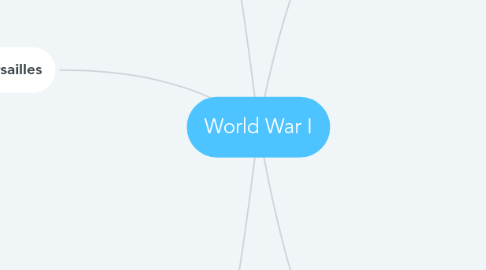
1. Battle of Verdun
1.1. b. February 1919
1.2. Germans attacked underground fortresses surrounding the city of Verdun
1.3. planned by Erich Von Falkenhayn
1.3.1. Wanted to demoralize the French
1.4. Lasted 10 months
1.5. 1 million killed
1.6. France was never a major part of the war after this battle
1.6.1. Germans exhausted
1.7. One of the most catastrophic battles
2. Treaty of Versailles
2.1. Big 4 met to decide Germanys fate
2.1.1. David Lloyd George (Great Britain)
2.1.1.1. wanted revenge
2.1.2. George Clemenceau (France)
2.1.2.1. Wanted revenge
2.1.3. Vittorio Orlando (Italy)
2.1.3.1. Italy hoped the gain territory
2.1.3.1.1. Didn't and went home
2.1.4. Woodrow Wilson (US)
2.1.4.1. Believed revenge would lead to another war
2.1.4.2. Was not like by Great Britain and France
2.2. Major ideas from 14 points
2.2.1. No secret treaties
2.2.2. Freedom of the seas
2.2.3. Armies only large enough for homeland security
2.2.4. Policies should include the interest of the people
2.2.5. League of nations will carry these ideas out
2.3. Weaknesses of the treaty
2.3.1. Focused on humiliating Germany
2.3.1.1. Huge war reparations
2.3.1.2. Colonies taken away
2.3.1.3. Demilitarized
2.3.1.4. Downsized
2.3.1.5. Ignored Franco-Prussian War
2.3.2. Did not include Soviet Union
2.3.3. Ignored colonial problems
2.3.3.1. Arabs and Indochina lead to later conflicts
2.3.4. Demilitarization not enforced
2.3.4.1. Rebuilt under Hitler
3. Allies
3.1. France
3.2. Britain
3.3. Russia
3.4. USA
3.4.1. Indirect involvement
3.4.1.1. Sent supplies to Great Britain
3.4.1.2. Honored Britains blockade in Germany
3.4.1.3. Cut off essential resources to Germany
3.4.2. Direct involvement
3.4.2.1. Enters in 1917
3.4.2.1.1. Unconditional submarine warfare
3.4.2.1.2. Zimmerman note
3.4.2.1.3. Germany wanted Mexico to start a border war
3.4.2.2. Arrives in France June 1917
3.4.2.2.1. Entry boosted moral
3.4.2.2.2. Brought food and supplies
3.4.2.3. Major battles
3.4.2.3.1. Belleau Wood
3.4.2.3.2. Argonne Forest
4. Trench Warfare
4.1. A form of military fighting where opposing sides fought one and other from trenches facing one and other.
4.2. War of Movement
4.2.1. A pattern of action and reaction where both sides advanced at one time
4.3. War of Attrician
4.3.1. Who could survive the longest and who would give in
4.4. Stale mate
4.4.1. Neither side can progress
4.5. Front line
4.5.1. First line of attack for the trenches
4.6. Support Line
4.6.1. Second line of trenches
4.6.2. Used for the frontline to retreat
4.7. Barbed wire
4.7.1. Used to ruin enemy attacks
4.8. Dugouts
4.8.1. Used for rest/shelter during attacks
4.9. No Man's Land
4.9.1. Area of land separating each of the trenches
4.10. Trenches were dug in a zig-zag pattern to confine an exploding shell to one small section
4.11. Communication trenches allowed food and equipment to be passed through the trenches without being exposed to the enemy
4.12. German trenches were generally better built than the allied trenches
4.12.1. This was because the Germans side saw them as long term
4.13. Battle of Mons
4.13.1. British and French slowed down Germanys advancement to Belgium
4.14. Battle of the Marine
4.14.1. Fought in north-western France
4.14.2. Allied forces won
5. Battle of Somme
5.1. Planned for May 1916, but started in June
5.2. Offensive launched by Britain
5.3. Wanted to attack in N. France
5.3.1. To relieve some of the pressure on the French at Verdun
5.4. Planned by Douglas Haig
5.5. 7 straight days of shelling
5.5.1. Shelling used to soften German attacks and destroy barbed wire
5.6. Sudden stop and British went over the top and walked through No Mans Land
5.6.1. Germans mowed them down
5.6.2. Barbed wire was still intact
5.7. Effects after Somme
5.7.1. Military disaster
5.7.2. 60,000 casualties
5.7.3. July 1st one of the most bloodiest days in British military
5.7.4. Sir Douglas Haig launched a similar offensive at Passchendaele
5.7.4.1. Soldiers drowned in the mud
